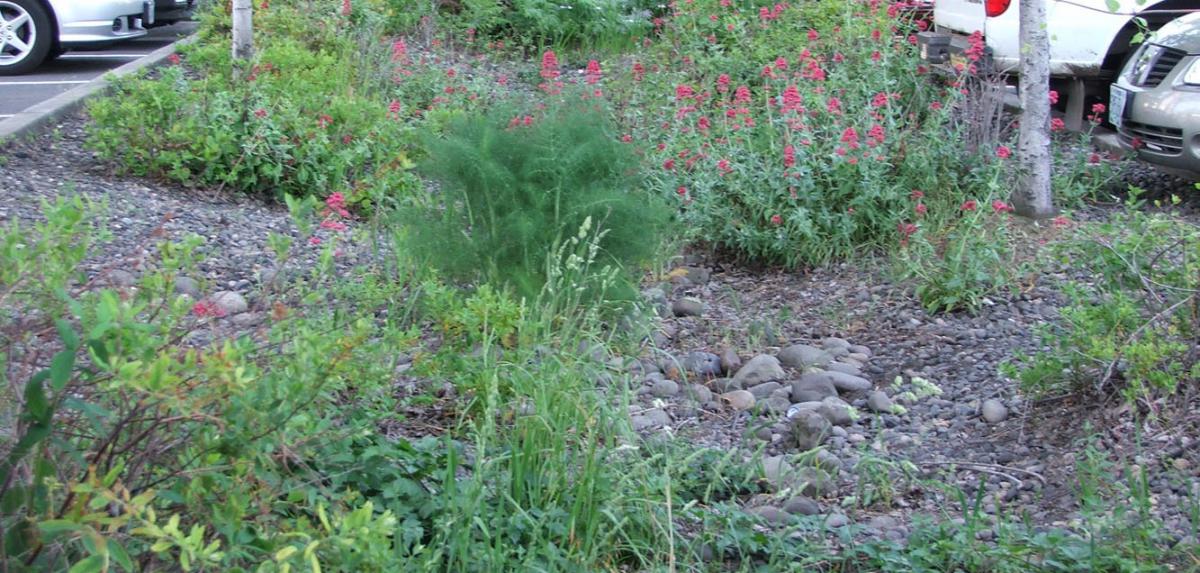Protecting water quality for drainage areas, ponds, and stream channels

Planted parking lot drainage areas are attractive ways to store and clean parking runoff.
How water runoff impacts water quality
INCREASED WATER RUNOFF
One average city block can generate five times more rainwater runoff than a woodland area of equal size. Why is this? Building roofs, concrete and asphalt do not allow rainwater to filter back into the ground-- instead it is carried off by drainpipes or allowed to sheet flow to a water collection area. This type of impermeable paving carries water very quickly and increases the amount and velocity of water to drains and collection points. Faster water can create flooding and erosion problems for others downstream.
In contrast, a mature woodland absorbs much of the water from an average rainfall with little runoff. Rainwater adheres to leaves and stems and is stored in the deep leaf layers on the ground. Woodland areas also have little compaction to the soil, allowing water to percolate into the ground instead of running across a compacted surface such as a lawn. Thus, the forest acts as a giant sponge before it releases water downstream. Allowing vegetated buffers along waterways performs in a similar way. Additionally, the more areas of mulch that you have on your property will allow for better rainwater storage and percolation.
INCREASED WATER POLLUTION
As water travels across a surface, it picks up oils, fertilizers, soil, pesticides, manure, and other chemicals from lawns, gardens, parking lots, roads, sidewalks, construction sites, and rooftops. All of these combine to wash downstream to create a toxic soup. In areas of dense development one good rainfall can ruin a stream’s ecology. It is difficult to see the difference between poor and good water quality in a stream as the changes are mainly chemical. If excessive silt or soil is washing into a stream or ditch, the water appearance can look muddy or silty. Waters with excessive nutrients from phosphorous or nitrogen can result in algal blooms that cover the surface. Excessive algae can deplete the water of oxygen causing mortality of fish and other aquatic life.
What can a homeowner do?
There are several ways to slow down, treat, and clean urban water runoff. Even if your property abuts no direct waterways or drainage channels, solutions for non-point water pollution always starts at the source to minimize further downstream affects.
These are a few steps that homeowners can do to minimize water quality impacts in your area:
- Use fertilizers, herbicides, and pesticides sparingly and only where necessary for spot control.
- Avoid excessive irrigation that causes water to run off of properties into street drains.
- Use alternative paving types for traditional concrete and asphalt materials. Brick, gravel, or pavers set on sand instead of mortared joints for sidewalks, patios, and driveways will allow for better soil infiltration reducing water runoff.
- Capture and store valuable rainwater for reuse with cisterns and rainbarrels.
- Capture and treat property runoff with raingardens.
- Use mulched areas underneath trees to absorb rainwater.
- Avoid excessive soil compaction from vehicles and heavy equipment on lawn areas.
- Capture water runoff from animal pens, barns, and corrals to a water detention area that will allow for soil infiltration and cleaning.
- Ensure that septic systems are inspected professionally every 3-5 years to check for leaks and proper drainfield operation.
Using vegetative buffer strips
One simple and easy method of slowing and cleansing water from pollutants and soil erosion is the use of vegetative buffer strips near water areas. As mentioned above, woodland systems are useful for allowing water infiltration, storage, and to assist in cleaning water; vegetative buffers are simply zones of larger vegetation allowed to grow where water flows. Vegetative buffers are extremely effective measures adjacent ponds, lakes, and stream edges. Mown lawn or pavement that allows surface drainage directly into water bodies can degrade water quality. By allowing dense vegetation to grow along the edges of water (where possible) allows for better water quality. The effectiveness of water cleansing depends upon the buffer width, and in general, the wider the buffer the more pollutants captured. Studies have shown that by allowing an agricultural field thirty feet wide along a waterbody to grow into a woodland results in nearly 100% reduction in previous soil sedimentation and pollutants.
An attractive alternative to allowing vegetation to grow along water edges is to plant wetland flowering and ornamental plants. The addition of iris, cattails, pickerel weed, rushes, powdery thalia, buttonbush and other water loving plants at the edges of streams and waterbodies creates a beautiful wetland garden.
Drainage areas and ditches can also be planted to slow stormwater and improve water quality. While maintaining a mowed turf in swales and ditches allows for some water infiltration, the addition of shrubs and trees enhances the effort. It is important to check with municipal engineers for permission to alter vegetation in drainage right of ways on private properties, and to prevent flooding near low lying structures, roads and residences.
Publications may download photograph at 200 ppi
These factsheets were written by Robert F. Brzuszek, Assistant Extension Professor, The Department of Landscape Architecture, Mississippi State University.
Publications
News
Mississippi growers and those across the Midwest and mid-South still have time to take advantage of two opportunities to improve soil health and water quality while protecting profitability on their farms.
Success Stories
Fenton Pope looked around his native Covington County a quarter-century ago and saw what he believed was an alarming amount of farmland out of production.
Billy Mitchell spent his childhood summers in the water and has lived at Pelahatchie Bay for more than three decades, so his dedication to protecting water resources now almost makes too much sense.
Cruising into Madison County, you see a cultivated urban landscape full of brick edifices and manicured lawns spring up around you. Your cell phone announces your turnoff, and you comply, turning onto an older road that soon turns to gravel.






